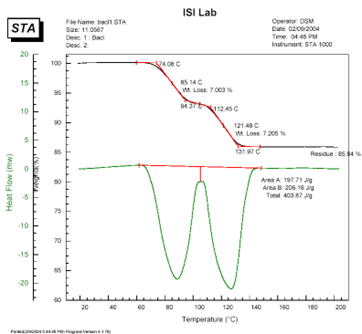Advanced Measurement Instruments
Copyright © 2025 Advanced Measurement Instruments
Background
Barium chloride dihydrate (BaCl₂·2H₂O) is a stable hydrate that retains its water of crystallization under ambient conditions. Upon heating, it undergoes a two-step dehydration process:
This predictable thermal behavior makes it an excellent system for evaluating both mass loss and enthalpy changes associated with dehydration, and an ideal reference material for evaluating STA instrument performance.
Experimental Conditions
Simultaneous thermogravimetric (TGA) and differential scanning calorimetric (DSC) signals were recorded using the AMI STA1000.
Results and Discussion
Figure 1 presents the DSC and TGA curves for barium chloride dihydrate. The TGA profile shows a clear two-step mass loss:
This close agreement confirms the high precision of the AMI STA1000 in quantitative mass analysis.
The DSC curve shows two distinct endothermic peaks, corresponding to the two dehydration steps. These peaks reflect the enthalpy required to break the lattice interactions that hold the water molecules in place. The difference in peak shape and temperature indicates different binding energies between the first and second hydration waters.

Figure 1: STA Curve
Why Hangdown Design Matters
The AMI STA1000 is the only true hangdown-style STA currently available on the market. In this configuration, the sample is suspended from the balance above the furnace, rather than resting on a platform or arm beneath it.
This design offers key advantages:
For laboratories requiring high precision in mass loss and thermal event detection, this configuration offers clear performance advantages over conventional STA geometries.
Conclusion
This study confirms the AMI STA1000’s exceptional precision in simultaneous DSC and TGA analysis. The dehydration of barium chloride dihydrate — a classic two-step thermal event — was measured with close agreement to theoretical values in both mass and enthalpy. The clarity of the thermal transitions and mass loss profile demonstrates the system’s reliability and resolution.